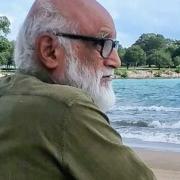David Ballantyne Rowley, Professor Emeritus in UChicago’s Department of the Geophysical Sciences, who specialized in paleoaltimetry, paleogeography, and tectonics, died May 30. He was 70.
As a research geologist, Rowley’s scientific work sought to understand the deep history and constant motion of Earth’s tectonic plates. He made significant contributions to the fields of paleogeography, paleoaltimetry, the formation of the Himalaya-Tibet Plateau, and the central role of heat from Earth’s core in driving tectonic movement. Rowley’s work earned recognition from the American Geophysical Union, where he was named a Fellow in 2018.
“Dave Rowley was a member of a dwindling and too often underappreciated class of earth scientists: an old-fashioned geologist with ‘good eyes’ that allowed him to see what most others would overlook and to understand how it can provide insight into geologic processes and history,” said longtime colleague Frank Richter, the Sewell Avery Distinguished Service Professor Emeritus of Geophysical Sciences at UChicago.
“As a geoscientist, he possessed exceptional quantitative and programming abilities and was one of the finest structural geologists I have ever had the pleasure to work with in the field,” said Miami University Professor Brian Currie, who worked with Rowley on five expeditions in Tibet, often in extremely challenging field conditions.
“David was an excellent departmental citizen, serving as chair for seven years and tirelessly promoting colleagues for professional recognition,” said colleague Andrew Davis, UChicago Professor of Geophysical Sciences. “He cared deeply about the University and the department.”
A Chicago “lifer”
Born on March 14, 1954, in Washington, D.C., Rowley was the second of four sons of UChicago scientists Janet D. Rowley and Donald A. Rowley. His early education included time at the University of Chicago Laboratory Schools and the New Experimental College in Skyum Bjerge, Denmark. Rowley graduated from Denison University and earned a PhD in geology from SUNY Albany, where he developed a passion and talent for fieldwork.
He joined UChicago in 1982 as a research associate, became a faculty member in the Department of the Geophysical Sciences in 1993, and received tenure in 2000.
Rowley’s research spanned a broad range of disciplines in the earth sciences, many focused on reconstructing global paleogeographic evolution: paleoaltimetry and paleohypsometry (localized and comprehensive estimations of topographic elevation across ancient landscapes, respectively); the history of tectonic plate production and destruction; and long-term sea level variation.
Some of his most notable research was on the age of initiation of the India-Asia collision. Published in 1996 and since cited more than 1,200 times, this work provided new insights into the chronology of one of the most dramatic geologic events of the past 100 million years, which led to the formation of the Himalayas.
Rowley also investigated the links between processes at Earth’s surface and in the planet’s deep interior. Having developed an extensive knowledge of the changes in the topography of continents and sea levels over millions of years, he worked with Forte to test whether computer models of Earth’s internal dynamics could explain the same data that he had compiled. This collaboration led to several publications on global changes in Earth’s continental elevations, sea level, and forces driving tectonic plate motions.
“David would spur me to reconsider central assumptions that had been long held by scientists in the geodynamics community,” said Forte. “This intellectual sparring was profoundly beneficial and led to some of our most important published work.”
“As a scientist, he was a contrarian,” said Harvard Professor of Geophysics Jerry Mitrovica, another long-time friend and collaborator. “And I mean in the best and most noble tradition of academia. He was a deep and creative thinker who questioned and overturned a series of deeply entrenched ideas in earth science.”
Rowley demonstrated that the present-day elevation of ice-age beaches had to be corrected for natural processes of deformation linked to plate tectonics before these elevations could be used to infer ice sheet stability, said Mitrovica. And “in a series of tour de force articles, he showed that the 50-year-old, textbook idea for the origin of long term (million-year time scale) sea level changes was grossly incomplete, motivating a recent explosion of research.”
As a professor at UChicago, Rowley was deeply committed to teaching and research, influencing students and colleagues with his passion and “almost encyclopedic knowledge,” said University of Florida Geological Sciences Professor Alessandro Forte, a close friend and collaborator of Rowley’s.
“Even as an early graduate student, I always felt like David treated me as a colleague,” said Penn State Assistant Professor Miquela Ingalls, PhD’17.
Rowley served as department chair from 1999 to 2006, editor of the Journal of Geology for more than 13 years, and mentor and advisor to countless students throughout his 31-year teaching career at the University. “He was a Chicago ‘lifer,’” said Davis.
To the horizon
According to Rowley’s family, his inclination to challenge established norms transcended his professional life: “Steeped in the countercultural ethos of the 1960s, throughout his life, David maintained a low tolerance for prescriptive and parochial value systems. He took every opportunity to question the status quo whenever he perceived injustice or arbitrary exertion of control.”
Outside of academia, Rowley loved spending time on the water and was a gifted sailor. Every spring, his family said, he awaited his first chance to sail out to the horizon and back on the family’s Hobie Cat. He was an avid hockey player and golfer, and he had an abiding love for the Indiana Dunes.
Rowley is survived by wife Nancy; children Jason, Jenny, and Gia, and their mother, Renee; stepdaughter Molly; brother Roger; sister-in-law Carise; and niece and nephew Anra and Ian.

